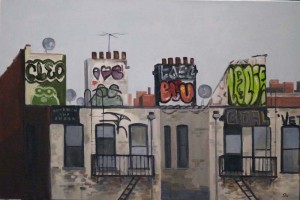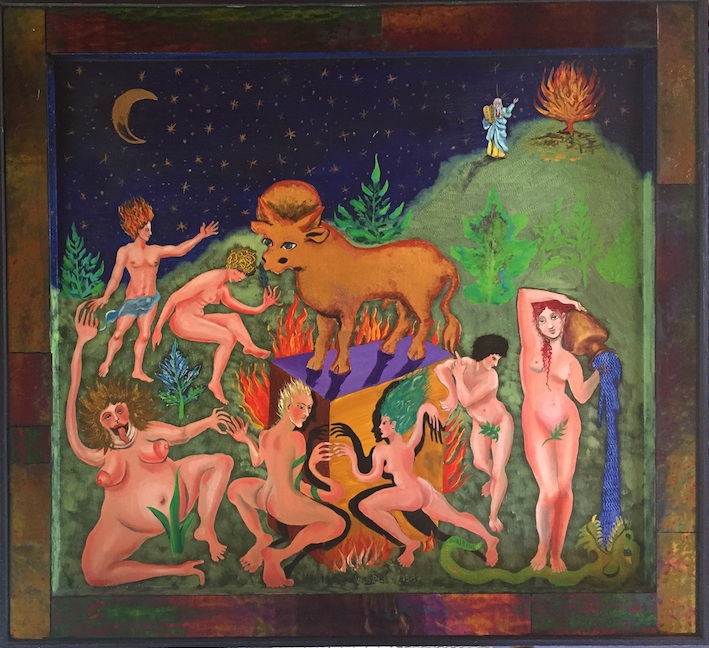The painting above is titled And Then They Were Gone, and it’s by New York artist Natalie Levy. I chanced across it in the window at 510 Warren Gallery in Hudson, NY, and at first thought it was a photograph; then there was a delicious fifteen-second transition in which I slowly realized it was a painting. I went in to enquire; I thought I couldn’t justify buying it, but I bought the gallery’s postcard of it; I stole the artist’s jpg of it (above) off her website and put it on my computer desktop; I went back later to see it again. And finally my wonderful wife bought it for me as a surprise. It now hangs in our living room.
It was an odd obsession, because I’m not generally attracted to urban landscapes, nor am I one of those who automatically considers graffiti art (unless it’s especially clever), nor have I ever lived anyplace that looks like this. But there are things about it in which I find affinities to my music: the symmetrical elements within a non-symmetry, the simple contrasts of color, the personal and playful embedded with the geometrical, the evident constructed-ness of something that nevertheless looks very natural. (In the actual painting, the sky is a little bluer and lighter than here, slightly luminescent.) I find it postminimalist in a musical sense, though that word means something entirely different in visual art than it does in music; postminimalist in the way it makes up a form through the irregular repetition of almost identical forms. And despite its simplicity, every time I look at it I find details I hadn’t noticed, which is an effect that I try to build into my music as well. Even the quadruple repetition of the smokestacks relates to my music, for I tend to repeat things in fours (ever since an undergrad composition teacher told me one could only get away with repeating something three times). I’ve never had another painting that I was in a position to acquire grab onto me and hold me the way this one does.
As a composer, I find it a bizarre concept to make art that someone else can buy and own, and that the artist might never see again. I think if someone owned my Transcendental Sonnets or Summer Serenade I would have to contact them every six months or so to ask how my piece was doing, and if it needed anything. So I contacted the artist so she’d know where it was and how much it meant to me. They must be used to the products of their talent going out the door, and I have no idea how they feel about the owner contacting them.
The only other original art I’ve ever bought was a biblical painting of Moses and the Golden Calf, which I got for a fraction of its undoubted value at a N.A.M.E. Gallery benefit in Chicago in the 1980s, by Chicago artist James McNeill Mesple:
This one is particularly hard to photograph; the frame and some of the interior paint are highly reflective, and the calf is actually bright gold, so it’s altered by whatever lights you’ve got on nearby. It being square, I’ve always thought it would make a lovely record cover for Moses und Aron. I love this one too, though it seems less related to my music.


